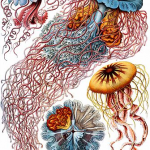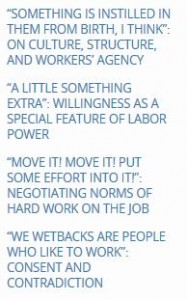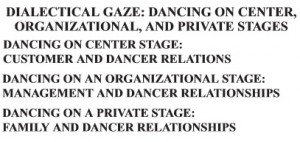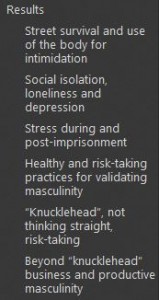Research prose has beginnings, middles and ends that collectively answer the questions “What happened?” and “Why should I care?” . The “middle” part of an article addresses the question, “what happened?” — in qualitative research, two types of information are supplied: a methods statement (how the data was collected) and the research outcomes (how the data can be understood).
has beginnings, middles and ends that collectively answer the questions “What happened?” and “Why should I care?” . The “middle” part of an article addresses the question, “what happened?” — in qualitative research, two types of information are supplied: a methods statement (how the data was collected) and the research outcomes (how the data can be understood).
The research outcomes in a qualitative research report constitute the “body” of the paper. The reader sees topical headings: words used to represent thematic analysis of the data. Even when the functional heading, Results, is used, the text itself is formatted according to the researcher’s conceptual analysis of the “raw” data communicated/signaled via topical headings. Within each thematic section, the writer must still craft a results section that includes explicit mention of data, and unique to qualitative research, an interpretative frame within which to understand the data. Thus, the qualitative outcomes section presents both the data itself as well as analysis of the data, analogous to numerical raw data that’s been run through statistical tests and parsed into figures for the reader’s consumption.
Below, we’ll first explore techniques for creating topical headings. Then, we’ll tackle the rather complex writing of the analysis itself.
Topical Headings: Tantalizing or Traditional?
Topical headings always represent the theme found in that section. Two major techniques for creating topical headings are using quotes from the data that embody the theme or crafting phrases that name the theme. These phrases can be literal conceptualizations or metaphorical in nature. Either technique can pull the reader in through a tantalizing hint of content or the reassuring cadence of plain speech. Whichever technique is chosen, the writer must maintain parallelism throughout the text. If a quote is used in one heading, then a quote must be used in all. If a two-part heading (e.g. heading: subheading format) is used in one, it should be used in all.
Tantalize
Qualitative research revels in meanings, distilling patterns out of an amorphous-seeming soup of information. Because representing humans as they are experienced by the researcher is such a challenge, one way to capture a theme is through the words of the humans themselves. Quotes and quoted phrases from informants is one strategy to represent outcomes. From a writing standpoint, this technique works only when every theme has a representative quote. If one section doesn’t, then use traditional headings that name the theme.
Another technique is using figurative language to capture the over-arching analysis while bridging the individual sections. Again, as with quotes, the figurative understanding must be well-motivated and make sense for each thematic section.
Examples || Willing to Work: Agency and Vulnerability in an Undocumented Immigrant Network / The Dialectical Gaze: Exploring the Subject-Object Tension in the Performances of Women who Strip
 |
 |
Analysis: In the first example, the writer begins each topical heading with a quote from an interview that captures the theme, which is named in the second half of the heading. Note the absolute parallelism of each heading! First is a quote formatted using quotation marks (rather than italics or some other highlighting feature), followed by a colon, then a noun-driven phrase conveying the core meaning of the theme for that section. In the second example, the writer adopts the “stage” as the metaphor guiding the entire analysis. The major heading, which is centered, supplies the idea of a performance stage and each of the subsequent headings employs the heading:subheading construction where the second part names the players in the relationships.
Traditional
The vast majority of outcomes are communicated using traditional headings that convey the idea using plain speech. These are easiest for the reader to understand, and invite less argument because fewer assertions are being made about how to understand the data. As with all headings, maintain grammatical parallelism throughout: all headings should be constructed using the same syntactic formula.
Examples || The “knucklehead” approach and what matters in terms of health for formerly incarcerated Latino men / ‘Waving the banana’ at capitalism: Political theater and social movement strategy among New York’s ‘freegan’ dumpster divers
 |
 |
Analysis: In the first example, the writer uses the functional subheading, Results, then employs topical headings for the content of each section. These are longer, more complex headings as well, and give the reader a good idea of what the focus of each section will be. In example two, short phrases are used until the final section, where the quote is employed to contrast the more prosaic titles as well as tie into the report’s title.
Performing Analysis in Text
- Evidence from study + Evidence from the literature –> evidence-driven dialogue
- relational dialogue: corroborate, conflict, clarify [check these]
- inductive: from data to analysis
- deductive: analysis proved through data
- parallelism at the textual level
- keeping constrained: analysis + literature within X/Y/Z theme (use theme to constrain and frame)
Let’s approach this inductively. Read through the body paragraph and its associated figure below and consider: what kinds of information are represented in this text? where does the information come from?
|
Nearby nature Scenery has been mentioned as an important feature of the environment related to physical activity for women (Eyler et al., 1998; King et al., 2000; Wilcox et al., 2000). The women whom I interviewed likewise spoke about qualities of the park related to nature, the outdoors, and greenery. Many of these women described the park as ‘beautiful,’ ‘pretty,’ ‘green’—or in the fall, many colors—and even some parts of the park as ‘astounding’ and ‘spectacular.’ It was, as they described it, a place where the air is relatively fresh and cool in hot weather, compared to its urban surroundings, and it was sometimes quiet, depending on the specific location within the park or the time of day. The park reminded some women of rural, ‘pastoral,’ or suburban places in the northeastern United States where they grew up (but not necessarily other regions), or it was one of the few open expanses available nearby for women who were raised in the city or were raising children there (Fig. 3). |
 ‘The only place to go and be in the city’: women talk about exercise, being outdoors, and the meanings of a large urban park ‘The only place to go and be in the city’: women talk about exercise, being outdoors, and the meanings of a large urban park |
Two types of information drive this text forward: evidence from the published literature and evidence from the study (data collected during the study). The paragraph begins with a literature-supported assertion which is corroborated by interview evidence from the study. The writing pattern manifests the analysis itself: “evidence from the literature” + “evidence from the study” yields “explication of their relationship”. It is evidence-driven dialogue.
Relational, Evidence-Driven Dialogue
Evidence-driven dialogue favors three typical relationships — corroborate, clarify, and conflict.
- Corroborate — evidence from the study supports, is similar to, or strengthens evidence from the literature
- Clarify — evidence from the study adds qualifying details to evidence from the literature, often in terms of narrowing scope or describing a particular population or site
- Conflict — evidence from the study contrasts or contradicts evidence from the literature.
Two other possible relationships are “additive” and “abductive”. In additive relationships, data from the study simply provides another body of detail without clearly supporting or clarifying existing evidence. If new data adds a new puzzle piece without impacting what already exists, then it is additive in nature.
Abductive reasoning is rather like making an intelligent guess about the contribution a piece of evidence makes to the existing literature. A clarifying relationship means the writer can say something definite about how data related to the literature, often in an argument form such as “In case X, but not for case Y” or “Like case Z, but more so for Z1“. Abductive relationships are less deductive in nature. Such pieces of evidence usually muddy the waters, making a body of evidence more complex or suggestive rather than definite.
Inductive or Deductive Pattern
In terms of planning the section itself, writers can move either inductively or deductively. Thus, you can start with evidence from the study, move to evidence from the literature, then finish with explanation — the inductive pattern — OR start with literature, then to evidence from the study, then finish with explanation: the deductive pattern.
Below is an example of each. The first example is deductive, and the second is inductive.
|
Nearby nature Scenery has been mentioned as an important feature of the environment related to physical activity for women (Eyler et al., 1998;King et al., 2000;Wilcox et al., 2000). The women whom I interviewed likewise spoke about qualities of the park related to nature, the outdoors, and greenery. Many of these women described the park as ‘beautiful,’ ‘pretty,’ ‘green’—or in the fall, many colors—and even some parts of the park as ‘astounding’ and ‘spectacular.’ It was, as they described it, a place where the air is relatively fresh and cool in hot weather, compared to its urban surroundings, and it was sometimes quiet, depending on the specific location within the park or the time of day. The park reminded some women of rural, ‘pastoral,’ or suburban places in the northeastern United States where they grew up (but not necessarily other regions), or it was one of the few open expanses available nearby for women who were raised in the city or were raising children there (Fig. 3). According to its original plan, conceived when the city (now borough) of Brooklyn was growing at a rapid pace, Prospect Park poses an exclusive opportunity for its users to experience nature within a densely populated urban environment (Fein, 1986). Certainly such contact with nature is important to everyone, but in some previous research women more often mentioned nature as a valuable part of their visits to Prospect Park (Taplin et al.,1998>) as well as parks in England (Curson and Kitts, 2000). Contact with nature in an otherwise hectic city seemed to be almost imperative for many of these women, for whom physical activity was at once an opportunity for fitness and an opportunity to be outdoors. As one woman who had lived in New York City her entire life said, ‘we don’t have a yard,’ and exercising in the park was a chance to experience nature, to feel ‘separated from the urban environment,’ and to escape the ‘cars [and] chaos of New York City.’ Some women explained the simple joy of having a place nearby where they could ‘pretend that you’re not in the city’ and take in different sights, sounds, and smells. Their comments, like those below, were similar to previous interviews, where park users valued the ‘sensory’ experience of Prospect Park (Taplin, 2002): And I like running in there in all the different seasons, so you can watch the seasons change. I really feel a lot better about living in New York. Because I can go in there and actually watch the seasons change…from week to week. You go out there for a long run, and you see differences, like well now that tree is red, and wow, now that tree has like half of its leaves gone, and now that tree is covered in snow. I mean, it sounds kind of corny, but I really like that. The park is, you know, just being outside and being surrounded by trees. And the smell—you know, the greenery, and flowers when the flowers are in bloom, but even just grass. And trees. And, you know, seeing the breeze move the trees around, you know, all that stuff is so great, compared to being…in this urban setting that we’re in most of the time. It’s just so wonderful, you can actually kind of pretend that you’re not in the city. It doesn’t even really matter where you are. It’s just a beautiful place. Some of these women expressed feelings that exercise in a gym or on the city streets was not as enjoyable or meaningful than in the park, not only because of the park’s aesthetic qualities, but also because of its ‘therapeutic’ and ‘spiritual’ qualities. Exercising in the park also allowed them to ‘zone out,’ contemplate, and organize their thoughts. They described a sense of ‘freedom’ and a chance to achieve a meditative state, which they described in terms like ‘peace of mind’ or ‘clearing out the cobwebs’. Others had some more specific insights into the ways that they were able to foster ‘mental health’ and ‘sanity’ by being physically active in the outdoors. These women observed that exercising in the park allowed them to resolve an emotional problem or an intellectual concept, for example, when taking a break from studying, allowing them to ‘settle in’ and to have ‘time . . . to be within myself.’ In fact, Olmsted’s landscape designs, including that of Prospect Park, were meant to encourage the kind of fascination, richness, and escape from everyday stimuli that are responsible for restoration of mental capacities (see Kaplan, 1995a). |
DANCING ON A PRIVATE STAGE: FAMILY AND DANCER RELATIONSHIPS
No one in Stacie’s family knew she had been stripping for almost a year. Every night before she left for work, she would call her mother. “That way,” she explained, “she would have talked to me once a day, and wouldn’t be likely to call later that night.” Stacie’s system of lies was working. Due to the nightly phone calls, her mother had no reason to wonder where she was. But one night she wanted to talk to someone, so she called her sister. “I felt so isolated and alone. So I told my sister.” Stacie thought she could tell her anything and really wanted to share it with her. “My mother told me she found out because someone saw me,” Stacie said with resignation. “But nobody would have seen me there. I mean, nobody that she knows. They are all church people and they wouldn’t have been there.” Stacie’s parents were so upset that her mother told her, “We know we are going to find you lying dead in a gutter somewhere.” Her parents stopped talking to her for three months. Then they began calling the club and asking for her by her stage name. When she would get on the phone they would tell her she was going to “burn in hell.” She had to continually change her stage name so that her parents wouldn’t know whom to ask for. I am struck by the ironic life of the stripper: privately she must hide what publicly she exposes. She can’t tell her family or close friends what she does; yet she can sit in a crowded restaurant and tell her secrets to me. * * * * * Throughout Western history and in numerous cultures, women have been paid to be attractive or to provide men with sexual gratification. If these women do so in traditional, heterosexual ways such as wife and mother, they are considered “Madonnas” or “good girls” (McCormick 1994, 83). However, if they are heterosexual women with multiple partners, or sex workers who exchange sexual services for money, they are “bad girls,” promiscuous, and “despised as ‘whores’ ” (McCormick 1994, 83). The good girl–bad girl dichotomy reflects cultural judgments regarding the (de)sexualization of women. To be good means to suppress one’s sexuality; to be bad means to express and embody sexuality. Strippers are caught among competing institutionalized forces regarding these bad girl–good girl performances (de Certeau 1984). The gaze of the center and organizational stages requires and legitimizes “bad girl” practices. Private relationships, including families, however, require them to maintain a “good girl” performance. As noted in previous research (e.g., Reid, Epstein, and Benson 1994a, 1994b; Ronai and Ellis 1989), the strippers at Paper Dolls employ identification tactics to resist the “bad girl” image. For example, they commonly referenced their own work in opposition to the strippers at another local club. “I thought these clubs were all prostitutes and drug addicts, dark walls and red lights,” Kit admits. “But it isn’t like that here,” she continues. “It’s not like the club down the street.” Other typical distinguishing comments are, “If you are going to prostitute yourself then you should just go to [other club].” “We are ‘good girls’ here; if you want ‘that,’you better go to the [other club].” “If guys come in looking for action like that, I send them to the [other club].” By projecting the “bad” characteristics associated with sex work on the other clubs, the strippers at Paper Dolls maintain their own “good girl” image in relation to the others… All the strippers I spoke with were keeping their stripping a secret from someone important in their lives. Like Phoenix, some were hiding it from their children. “My daughters only know that I work in a big people’s place,” Annie says. Others were hiding it from parents: “I was raised with conservative midwestern ideals. I will never tell my parents what I am doing,” explains Debra. In this way, many dancers engage in “defensive strategies” to maintain their secret identities (Goffman 1959). They ambiguously tell people that they dance, that they are entertainers, or that they “work in a bar.” Annie, whose father is the deacon of a church, says, “When people ask me directly, I don’t lie. I mean I am a dancer. They don’t need to know that I take my clothes off.” Others employ more extensive defensive practices. Kit tells people she is a teacher (she does teach children physical fitness part-time at a local community center). All but three of Debra’s family and friends believe she is a nurse’s aide. She says, I lie. I am a liar now. I have become a liar. I can honestly say that before [this job] I was a very honest person. But now I lie. I lie about my lies. I can’t remember who I told what or where I am supposed to be on this night. Through her secrets and lies, the stripper is not only on stage while she is dancing; she is on stage in her private life as well. However, unlike the strategic secrets she keeps from the customers where she and the patrons play “let us make-believe,” the secrets she keeps in her personal relationships are dark. Goffman (1959) described a dark secret as one kept in a relationship in which there are no expectations that any secrets should be kept. The audience does not know or expect that any secret is being kept so the performance is framed in what Turner (1988) would call “let us believe.” If her dark secrets are discovered, her carefully constructed “good girl” image is destroyed, as stripping is incompatible with the image of self that she attempts to maintain before her private audience…. |
Analysis: In the first example, the writer begins with the published literature, then turns to the study’s evidence in a supporting relationship, and continues this dialogue, using quotes as needed to demonstrate corroboration. The second example begins with a narrative interpretation of field notes (hence, evidence from the study), then explains the narrative through the existing literature, using both quotes and the literature to support a largely corroborative relationship.
The example below is additive in nature: the writer explores the situation using evidence, but doesn’t explicitly tie the data to the literature. Instead, the quotes demonstrate the thematic relationships adding to what the reader knows, but not relating in any particular way to existing theory.
Example || First assessments by specialist cancer nurses in the community: An ethnography
Threats to trust and relationship building
Within the first assessment patients are given the time and space to tell their story and to express their grief and this helps with developing trust:
N5: ‘I just want to get them on board and to feel as if they can trust me and they feel safe with me and I wouldn’t put anything in jeopardy of that. I don’t want anything to upset that, especially on that first assessment visit’.
There was concern expressed by N5 that use of the SCC could compromise the relationship building process and could potentially be a barrier to building trust, ‘being too much’ on a first visit, by changing the dynamics of the embryonic relationship.
N3 reports how using the SCC has the potential to cause a distraction and impede the ‘flow’ in the work of ‘building a relationship’. Rather than enabling the relationship process, the SCC was perceived negatively by N3 as ‘a bit of paper’ which was going to ‘bombard’ the patient with a burden:
N3: ‘I normally like to sort of ask the patient verbally and let them verbalise their concerns rather than handing them a bit paper and say ‘tick the boxes’, I much prefer to sort of ask….rather than bombard them’.
This nurse expressed a preference for using an informal approach to information gathering. She describes the paper work as a barrier to the patient expressing their concerns. She is concerned about making too many demands on the patient related to form filling. She is more interested in facilitating the verbal expression of the patient’s story rather than the SCC paper work, which similar to N5 was viewed as overly bureaucratic.
The SCC appeared to be a threat to the relationship building process in that it was seen as bureaucratic and impersonal:
N5: ‘people fill in so many forms these days and paperwork. Some people actually turn round and say ‘not another form’ and that puts me off straight away. I think this interview is supposed to be about something else, we’re going on a, for me, its going on a journey together, exploring about where they’ve come from and where they’re at and where they’re going and we’re doing that together. It’s not as harsh as filling out a form….coming back to this trust and building relationship I don’t want them to remember me as being a burden – I want that first visit to be helpful to them’
N5 is concerned that the SCC represented ‘harshness’ and may damage her presentation as a ‘nice’ professional by being seen as a ‘burden’ to the patient, especially when the patient objects to having another form to fill in. The specialist nurses wish to facilitate the patient’s story and to connect on their journey together. The SCC is perceived as a bureaucratic burden by N3, N5 and N6 and a barrier to relationship building and building rapport.
Analysis: The writer explains what each data excerpt means to the theme, and finishes with the overall claim about this section.
Stylistics Note
Keep it Parallel
Organizationally, the major tactic used to structure information is text-level parallelism. Just like sentence-level parallelism in a list, at the level of text, all sections feature pieces of information in the same order: if you start one thematic section with a quote, then start every thematic section with a quote. All sections are either deductive, inductive, or abductive. Qualitative research is complicated stuff! Readers work hard to follow logic, evidence, theory, and claims. Parallelism increases comprehension because it capitalizes on unconscious pattern-seeking behavior. Your human reader will build a schema in their heads about how you write information; the more you follow the same schema, the more you maximize credibility and comprehension.
Keep it Constrained
Despite its frequent literary feel, qualitative research is still science: your job as the writer of science is to make the knowledge as easy to understand as possible while honoring the complexity of the topic. One way we do this is by modularizing information. Simply put, this means placing together ALL of the information about a topic and ONLY the information about that topic in any particular section. Do this at the level of the paragraph (ground zero for reader comprehension) and at the level of the thematic section. Only the information relevant to a specific theme should be included in that section of the paper.